Najaf
Najaf (Arabic: ٱلنَّجَف) or Al-Najaf al-Ashraf (Arabic: ٱلنَّجَف ٱلْأَشْرَف), also known as Baniqia (Arabic: بَانِيقِيَا) is a city in central Iraq about 160 km (100 mi) south of Baghdad. Its estimated population in 2013 was 1,000,000 people.[2] It is the capital of Najaf Governorate. It is widely considered the third holiest city of Shia Islam (after Mecca and Medina), the Shi'ite world's spiritual capital, and the center of Shi'ite political power in Iraq.[8]
Najaf ٱلنَّجَف al-Najaf al-Ashraf, Baniqia | |
|---|---|
.jpg) Masjid al-Imam ‘Ali, one the most important sites of Najaf | |
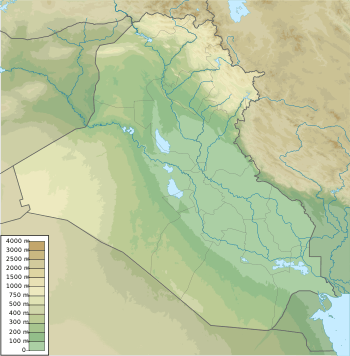 Najaf Location of Najaf within Iraq | |
| Coordinates: 32°00′00″N 44°20′00″E | |
| Country | |
| Province | Najaf Governorate |
| Elevation | 60 m (200 ft) |
| Population (2014) | |
| • Total | 1,389,500[1] |
| Approximate figures[2] | |
| Time zone | UTC+3 |
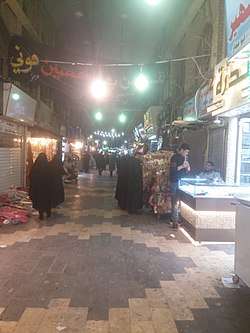
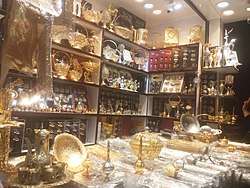
Religious significance
Al-Najaf is considered sacred by Shi'a Muslims. An-Najaf is renowned as the site of the burial place of Muhammad's son in law and cousin, Imam ‘Alī ibn Abī Tālib. The city is now a center of pilgrimage throughout the Shi'ite Islamic world. It is estimated that only Mecca and Medina receive more Muslim pilgrims. As the burial site of Shi'i Islam's second most important figure,[9] the Imam Ali Mosque is considered by Shiites as the third holiest Islamic site.[18]
The Imam ‘Ali Mosque is housed in a grand structure with a gold gilded dome and many precious objects in the walls. Nearby is the Wadi-us-Salaam cemetery, the largest in the world.[19] It contains the tombs of several prophets and many of the devout from around the world aspire to be buried there, to be raised from the dead with Imām ‘Alī on Judgement Day. Over the centuries, numerous hospices, schools, libraries and convents were built around the shrine to make the city the center of Shīʻa learning and theology.
The Al-Najaf seminary is one of the most important teaching centres in the Islamic world. Ayatollah Khomeini lectured there from 1964 to 1978.[2] Many of the leading figures of the new Islamic movement that emerged in Iraq, Iran and Lebanon in the 1970s had studied at Najaf.[20]
Najaf, alongside Karbala, is considered a thriving pilgrimage destination for Shia muslims and the pilgrimage industry in the city boomed after the end of Saddam Hussein's rule.[21] However, due to the US sanctions on Iran, the number of Iranian pilgrims dropped significantly.[22]
Geography
Climate
Najaf has a hot desert climate, BWh in the Köppen climate classification, with long, very hot summers and mild winters. The average annual temperature is 23.6 °C. The rainfall averages 69 mm.
| Climate data for An Najaf | |||||||||||||
|---|---|---|---|---|---|---|---|---|---|---|---|---|---|
| Month | Jan | Feb | Mar | Apr | May | Jun | Jul | Aug | Sep | Oct | Nov | Dec | Year |
| Average high °C (°F) | 14 (58) |
18 (65) |
23 (74) |
30 (86) |
36 (97) |
41 (105) |
42 (108) |
42 (107) |
39 (102) |
33 (91) |
23 (74) |
17 (62) |
30 (86) |
| Average low °C (°F) | 7 (44) |
9 (49) |
13 (56) |
19 (66) |
23 (74) |
28 (82) |
29 (85) |
29 (84) |
27 (80) |
21 (70) |
13 (55) |
8 (47) |
19 (66) |
| Record low °C (°F) | −7.2 (19.0) |
−4.5 (23.9) |
2.2 (36.0) |
7.0 (44.6) |
13.0 (55.4) |
17.8 (64.0) |
19.4 (66.9) |
22.2 (72.0) |
18.3 (64.9) |
7.0 (44.6) |
0.2 (32.4) |
−2.5 (27.5) |
−7.2 (19.0) |
| Average precipitation cm (inches) | 2.5 (1) |
1.3 (0.5) |
1.3 (0.5) |
1.3 (0.5) |
0.51 (0.2) |
0 (0) |
0 (0) |
0 (0) |
0 (0) |
0.51 (0.2) |
1.0 (0.4) |
1.0 (0.4) |
6.9 (2.7) |
| Source 1: Weatherbase[23] | |||||||||||||
| Source 2: [24] | |||||||||||||
History
The area of An-Najaf is located 30 km south of the ancient city of Babylon, and 400 km north of the ancient city of Ur. The city itself was founded in 791 [AD], by the Abbasid Caliph Harūn ar-Rashīd, as a shrine to ‘Alī bin Abī Ṭālib.[25]
Prehistoric and ancient times
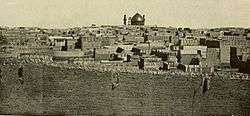
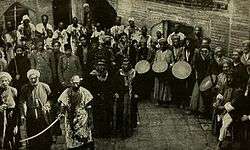
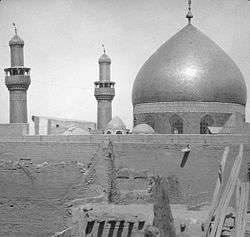
Archaeological discoveries show the existence of a populace dating back to the 1st century BC. Najaf possesses one of the largest burial grounds in the vicinity for Christians. The centuries following have proven this to also be a city with a multicultural and religious people. Mohammed al-Mayali, director of Inspectorate Effects of the province of Najaf, states "the excavation on the graves, which we have been working on for years, confirm that "Najaf" contains the largest Christian cemetery in Iraq, with a cemetery area of 1416 acres. We have found indications of Christianity on the graves through representations of crosses and stones with Christ-like engravings. There are also relics that date back to the Sassanid period. Also discovered in the excavation was proof of a thriving glass industry. Pots were decorated with the cross. as well as Hebrew writings, indicating a community of religious coexistence."
Wadi-us-Salaam in Najaf was a holy cemetery for Jewish and was Najaf called at that time Baniqia, and could be this is the first name of Najaf area.[26] [27]
The name Baniqia also was found in some texts which tell that in one day Abraham visited this village and stayed couple of days, then he continued in his journey from Mesopotamia to Arabia. [28] [29]
In Islam, the city is considered to have started with Ali who instructed that his burial place should remain a secret, as he had many enemies and he feared that his body might be subjected to some indignity. According to legend, the body of Ali was placed on a camel which was driven from Kufah. The camel stopped a few miles west of the city where the body was secretly buried.[30] No tomb was raised and nobody knew of the burial place except for a few trusted people. It is narrated that more than a hundred years later the Abbasid Caliph, Harun al-Rashid, went deer hunting outside Kufah, and the deer sought sanctuary at a place where the hounds would not pursue it. On inquiry as to why the place was a sanctuary Harūn ar-Rashīd, he was told that it was the burial place of ‘Ali. Harūn ar-Rashīd ordered a mausoleum to be built on the spot and in due course the town of Najaf grew around the mausoleum.
Medieval and modern history
In early 14th century Sheikh Ibn Battuta visited the burial site of Ali ibn Abi Talib during his travels in Iraq after his pilgrimage to Mecca. During this period Najaf was called Meshhed Ali. As Translated by Samuel Lee, Ibn Battuta in his Arabic Rihla relates:[31]
"We next proceeded to the city of Meshhed Ali where the grave of Ali is thought to be. It is a handsome place and well peopled; all the inhabitants, however, are of the Rafiza (or Shiah) sect. There is no governor here, except a sort of tribune. The inhabitants consist chiefly of rich and brave merchants. About the gardens are plastered walls adorned with paintings, and within them are carpets, couches and lamps of gold and silver. Within the city is a large treasury kept by the tribune, which arises from the votive offerings arrived from different parts: for when anyone happens to be ill, or suffer under any infirmity, he will make a vow, and thence receive relief. The garden is also famous for its miracles; and hence its believed that the grave of Ali is there. Of these miracles the "night of revival" is one: for, on the 17th day of the month Rejeb, cripples come from different parts of Fars, Room, Khorasaan, Irak, and other places, assemble in companies from twenty to thirty in number. They are placed over the grave soon after sun-set. People then, some praying, some reciting the Quran, and others prostrating themselves, wait expecting their recovery and rising, when about night, they all get up sound and right. This is a matter well known among them: I heard it from a creditable person, but was not present at one of those nights. I saw, however, several such afflicted persons, who had not yet received, but were looking forwards for the advantages of this "night of revival".
In the 16th century, Najaf was conquered by the Ottoman Empire. The Safavid dynasty of Iran maintained continuous interest to this Shia site. During the Ottoman–Safavid War (1623–39), they were twice able to capture the city, but lost it again to the Ottomans in 1638.
Under the rule of the Ottoman Empire, Najaf experienced severe difficulties as the result of repeated raids by Arab desert tribes and the Persian army with acute water shortages causing lack of a reliable water supply. The number of inhabited houses in the city had plummeted from 3,000 to just 30 by the start of the 16th century.
When the Portuguese traveller Pedro Texeira passed through Najaf in 1604, he found the city in ruins, inhabited by little more than 500 people.[32] This was largely the result of a change in the course of the Euphrates river eastwards in the direction of Hilla, leaving Najaf and Kufa high and dry, leading to the destruction of the local formerly rich agriculture, demise of the palm groves and orchards, followed by the salinization of the underground water due to evaporation.
During the 18th century the scholarly life of Najaf came to be dominated by Farsi-speaking ‘Ulema’ (Arabic: عُلُمَاء, Scholars) from Iran.[33]
The water shortages were finally resolved in 1803 when the Euphrates made its way to the city once again. The shift in the river's flow was the product of a century-long effort by the Ottomans to shift the flow of the river, so as to deprive marsh-dwelling tribes like the Khaza'il of the watery environment that allowed them to evade state control. These long-term efforts rendered successful the construction of the Hindiyya Canal in 1793, which further shifted the flow of the Euphrates. These hydrological shifts were to have religious implications. Most notable was the consolidation and spread of Shi'ism. As the shrine city of Najaf gained access to water again, its notables and holy men began to wield considerable power in the area.[34]
The Ottomans were expelled in an uprising in 1915, following which the city fell under the rule of the British Empire. The sheikhs of Najaf rebelled in 1918, killing the British governor of the city, that is Sayyed Mahdi Al-Awadi, and cutting off grain supplies to the Anaza, a tribe allied with the British. In retaliation the British besieged the city and cut off its water supply. The rebellion was put down and the rule of the sheikhs was forcibly ended. A great number of the Shi‘i ‘Ulema’ were expelled into Persia, where they set the foundations for the rise of the city of Qom as the center of the Shi‘ite learning and authority, in lieu of Najaf. Najaf lost its religious primacy to Qom, and was not to regain it until the 21st century, during the establishment of a Shī‘ī-majority government in Iraq after 2003.
Post–Saddam Hussein period
During the 2003 invasion of Iraq, Najaf was a key target of the invading United States forces. The city was encircled during heavy fighting on 26 March 2003 and was captured on 3 April 2003.
The clerical authorities of the Shī‘ī enclave of Sadr City in Baghdad, which claimed autonomy in April 2003, after the fall of Baghdad, claimed to be taking their orders from senior clerics in Najaf.
On 4 April 2004, the Mahdi Army attacked the Spanish-Salvadoran-ALARNG base (Camp Golf, later renamed Camp Baker) in An Najaf, part of a coordinated uprising across central and southern Iraq in an apparent attempt to seize control of the country ahead of the 30 June 2004 handover of power to a new Iraqi government. This uprising led to the American troops arriving in the city in the wake of the Spanish withdrawal. In August 2004, heavy fighting broke out again between US forces and Al-Sadr's Mahdi Army. The battle lasted three weeks and ended when senior Iraqi cleric Grand Ayatollah ‘Alī Al-Sīstānī negotiated an end to the fighting.
See also
- Battle of Najaf (2003)
- Battle of Najaf (2004)
- Battle of Najaf (2007)
- Big Four (Najaf)
- Al Najaf International Airport
- Al-Hannanah mosque
- Karbala’ and other places in Iraq
References
- "Iraq: Governorates, Cities, Towns, Municipal Districts - Population Statistics in Maps and Charts". www.citypopulation.de.
- Ring, Trudy (1996). "Najaf". Global Security. Retrieved 2009-09-13.
- Cordesman, Anthony H.; Khazai, Sam (4 Jun 2014). Iraq in Crisis. Rowman & Littlefield. p. 319. ISBN 9781442228566.
- Cockburn, Patrick (8 Apr 2008). Muqtada: Muqtada al-Sadr, the Shia Revival, and the Struggle for Iraq (illustrated ed.). Simon and Schuster. p. 146. ISBN 9781416593744.
- Pollack, Kenneth M.; Alkadiri, Raad; J. Scott Carpenter; Kagan, Frederick W.; Kane, Sean (2011). Unfinished Business: An American Strategy for Iraq Moving Forward. Brookings Institution Press. p. 103. ISBN 9780815721666.
- Robinson, Linda (2005). Masters of Chaos: The Secret History of the Special Forces (illustrated, reprint ed.). PublicAffairs. p. 260. ISBN 9781586483524.
- "Ali al-Sistani is Iraq's best hope of curbing Iranian influence. But he is 85 and has no obvious successor". The Economist. 5 December 2015. Retrieved 6 December 2015.
- [3][4][5][6][7]
- Never Again! Archived 2007-08-05 at the Wayback Machine ShiaNews.com
- Iran Diary, Part 2: Knocking on heaven's door Asia Times Online
- Muslim Shiites Saint Imam Ali Holy Shrine - 16 Images Archived 2010-09-05 at the Wayback Machine Cultural Heritage Photo Agency
- The tragic martyrdom of Ayatollah Al Hakim calls for a stance Archived 2010-09-18 at the Wayback Machine Modarresi News, September 4, 2003
- Zaman Online, August 13, 2004 Archived October 28, 2006, at the Wayback Machine
- Why 2003 is not 1991 The Guardian, April 1, 2003
- Iraqi forces in Najaf take cover in important Shia shrine, The Boston Globe, April 2, 2003. "For the world's nearly 120 million Muslim Shiites, Najaf is the third holiest city behind Mecca and Medina in Saudi Arabia."
- Religious rivalries and political overtones in Iraq CNN.com, April 23, 2003
- Godlas, Alan. "Muslims, Islam, and Iraq". www.uga.edu. Archived from the original on 2011-10-06. Retrieved 2010-10-15.
- [9][10][11][12][13][14][15][16][17]
- Hala Mundhir Fattah; Caso, Frank (2009). A brief history of Iraq. Infobase Publishing. p. 140. ISBN 978-0-8160-5767-2. Retrieved 2010-10-18.
- Mallat, Chibli (2004). The Renewal of Islamic Law: Muhammad Baqer As-Sadr, Najaf and the Shi'i International. Cambridge University Press. Retrieved 2009-09-13.
- "Iraq's holy cities enjoy boom in religious tourism". Al Arabiya. 4 April 2013.
- "Iraq's city of Najaf suffers as Iranian tourist numbers drop". The National. 20 February 2019.
- "Weatherbase: Historical Weather for An Najaf, Iraq". Weatherbase. 2011. Retrieved on November 24, 2011.
- http://docs.lib.noaa.gov/rescue/data_rescue_iraq.html#o48577960
- Ring, Trudy (1996). International Dictionary of Historic Places: Middle East and Africa. Taylor & Francis. Retrieved 2009-09-13.
- A'haron Oppenheimer; Oppenheimer, Nili (2005). Between Rome and Babylon: Studies in Jewish Leadership and Society. Mohr Siebeck. p. 351. ISBN 9783161485145.
- Bryan Hill. ["Wadi Al-Salam: Magnificent Ancient Cemetery in Iraq is Largest in the World"], Ancient Origins, 23 July 2018.
- Brendan Koerner. ["Why Is Najaf So Holy?"], Slate, 27 April 2004.
- Imam Ali Holy Shrine. ["Baniqia Article ID 4648"], Imam Ali Network .
- Farag, George (2007). Diaspora and Transitional Administration: Shiite Iraqi Diaspora and the Administration of Post-Saddam Hussein Iraq. ProQuest. pp. 133–4. ISBN 9780549410034.
- Batuta, Ibn; Lee, Samuel (1829). The travels of Ibn Batūta;. London, Printed for the Oriental translation committee, and sold by J. Murray [etc.] pp. 31–33. Retrieved 11 June 2018 – via Internet Archive.
- Nakash, Yitzhak (2003). The Shi'is of Iraq. Princeton University Press. Retrieved 2009-09-13.
- Yitzhak Nakash, The Shi'as of Iraq (Princeton: Princeton University Press, 1994) p. 16
- Husain, Faisal (October 2014). "In the Bellies of the Marshes: Water and Power in the Countryside of Ottoman Baghdad". Environmental History.
Further reading
- Published in the 19th-20th centuries
- Charles Wilson, ed. (1895), "Nejef", Handbook for Travellers in Asia Minor, Transcaucasia, Persia, etc., London: John Murray, OCLC 8979039
- "Nejef", Encyclopædia Britannica (11th ed.), New York: Encyclopædia Britannica Co., 1910, OCLC 14782424
- Published in the 21st century
- C. Edmund Bosworth, ed. (2007). "Najaf". Historic Cities of the Islamic World. Leiden: Koninklijke Brill. ISBN 9004153888.
- Michael R. T. Dumper; Bruce E. Stanley, eds. (2008), "Najaf", Cities of the Middle East and North Africa, Santa Barbara, Calif.: ABC-CLIO, ISBN 1576079198
External links
| Wikimedia Commons has media related to Najaf. |
| Wikivoyage has a travel guide for Najaf. |